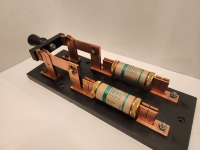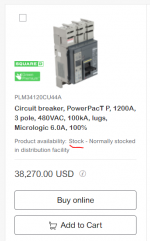wwhitney
Senior Member
- Location
- Berkeley, CA
- Occupation
- Retired
To expand on this, looks like to use a fuse at a continuous load of 100% of its rating, you need to use a UL 977 (Fused Power Circuit Devices) switch. That standard says "1.2 Fused power-circuit devices . . are considered to be either bolted pressure contact switches or high-pressure butt-type contact switches." Oddly, it doesn't discuss 100% rating that I could see on a quick perusal, but it also doesn't have the UL 98 language imposing an 80% continuous load limit across the board.Almost all bolted pressure switches are 100% rated by design, but enclosure manufacturers may not provide enough ventilation.
The standard also specifies that fused power circuit devices have provisions for mounting fuses larger than 600A. So I guess if you want to use a fuse of 600A or smaller with a continuous load of 100% of the fuse rating, you're out of luck?
Cheers, Wayne



